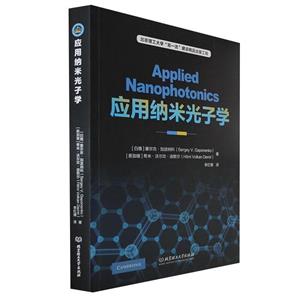
作者:孙萌涛、王鑫鑫、宗欢
页数:280
出版社:清华大学出版社
出版日期:2018
ISBN:9787302539186
电子书格式:pdf/epub/txt
内容简介
本书详细介绍了纳米光子和光谱的原理和应用。首先通过高真空很好增强拉曼光谱仪揭示了表面等离激元增强的线性拉曼光谱的物理机制,然后详细介绍了表面等离激元增强的非线性拉曼光谱的实验和理论研究,以及双光子激发荧光和二次谐波产生信号的原位同步测量。本书物理概念清晰详细,全面介绍了本领域的近期新研究成果。本书可作为科研院所和大学科研工作者从事本领域科学研究的参考资料,也可作为物理系专业研究生和高年级本科生学习纳米光子学领域的参考书。
作者简介
北京科技大学担任教授和博导。孙萌涛教授长期从事基于表面等离激元增强的分子拉曼光谱的实验和理论研究,研发高真空针尖增强拉曼光谱仪,实现目标分子拉曼光谱的超灵敏检测,并揭示表面等离激元增强拉曼光谱的物理和化学机制,以通讯作者(或第一作者)在国际重要学术期刊上发表SCI论文超过180篇(其中ESI高引论文11篇),所有论文引用超过6100次,H-index 43,曾15次应邀在国际重要学术期刊撰写本领域的综述,应邀撰写英文专著(科学出版社)五本(第一作者)。2017年2月,孙萌涛教授获得辽宁省科学技术(自然科学)二等奖(个人第二)。
本书特色
本书详细介绍了纳米光子和光谱的原理和应用。首先通过高真空尖端增强拉曼光谱仪揭示了表面等离激元增强的线性拉曼光谱的物理机制,然后详细介绍了表面等离激元增强的非线性拉曼光谱的实验和理论研究,以及双光子激发荧光和二次谐波产生信号的原位同步测量。本书物理概念清晰详细,全面介绍了本领域的最研究成果。本书可作为科研院所和大学科研工作者从事本领域科学研究的参考资料,也可作为物理系专业研究生和高年级本科生学习纳米光子学领域的参考书。
目录
CHAPTER 1Introduction
1.1Concept of Spectroscopy
1.2Concept of Photonics and Plasmonics
1.3Concept of Plasmon睧nhanced Spectroscopy
1.3.1Plasmon瞖nhanced fluorescence
1.3.2Plasmon瞖nhanced resonance fluorescence energy
transfer
1.3.3Surface瞖nhanced Raman scattering
1.3.4The remote瞖xcitation of SERS
1.3.5Tip瞖nhanced Raman scattering spectroscopy
1.3.6Remote excitation睺ERS microscopy
1.3.7Plasmon瞖nhanced coherence anti睸tokes
Raman scattering images
References
CHAPTER 2Molecular Spectroscopy
2.1Jablonski Diagram
2.2Electronic State Transition
2.2.1Ultraviolet瞯isible瞡ear IR absorption
spectroscopy
2.2.2Two瞤hoton absorption spectroscopy
2.2.3Fluorescence spectroscopy
2.2.4Fluorescence resonance energy transfer
2.3Vibration Spectroscopy
2.3.1Raman spectroscopy
2.3.2Infrared spectroscopy
2.3.3Modes of molecular vibration
2.3.4The difference between Raman and spectra
2.4Rotational State
2.5Electronic and Vibrational Spectroscopy by Circularly
Polarized Light
2.5.1Electronic circular dichroism
2.5.2Raman optical activity
References
CHAPTER 3Photonics and Plasmonics
3.1Introduction
3.2Exciton
3.2.1Brief introduction of exciton
3.2.2Exciton classification
3.3Polariton
3.3.1Brief introduction of polariton
3.3.2Polariton types
3.4Plasmon and Surface Plasmons
3.4.1Plasmons
3.4.2Surface plasmons
3.4.3Surface plasmon polaritons
3.5Plasmon睧xciton Coupling: Plexciton
References
CHAPTER 4Surface Plasmon
4.1Brief Introduction of Surface Plasmon
4.2Physical Mechanism of Surface Plasmon
4.2.1Drude model
4.2.2Relationship between refractive index and
dielectric constant
4.2.3Dispersion relation
4.3Localized Surface Plasmon
4.4Plasmonic Waveguide
4.4.1The electromagnetic theory for calculating NWs
4.4.2The decay rate in the plasmon mode
4.4.3The spontaneous emission near the nanotip
4.4.4SPP modes of Ag NW by one end excitation
References
CHAPTER 5Plasmon睧nhanced Fluorescence Spectroscopy
5.1The Principle of Plasmon睧nhanced Fluorescence
5.2Plasmon睧nhanced Upconversion Luminescence
5.2.1Brief introduction
5.2.2Physical principle and mechanism
5.3Principle of Plasmon睧nhanced FRET
References
CHAPTER 6Plasmon睧nhanced Raman Scattering Spectra
6.1Surface睧nhanced Raman Scattering Spectroscopy
6.1.1Brief history of SERS spectroscopy
6.1.2Physical mechanism of SERS spectroscopy
6.2Tip睧nhanced Raman Scattering Spectroscopy
6.2.1Brief introduction of TERS spectroscopy
6.2.2Physical mechanism of TERS spectroscopy
6.2.3Setup of TERS
6.3Remote睧xcitation SERS
References
CHAPTER 7High睼acuum Tip睧nhanced Raman Scattering
Spectroscopy
7.1Brief Introduction
7.1.1Brief description of setup of HV睺ERS
7.1.2Detailed description of setup of HV睺ERS
7.2The Application of HV睺ERS Spectroscopy in in situ
Plasmon睤riven Chemical Reactions
7.3Plasmonic Gradient Effect
7.4Plasmonic Nanoscissors
References
CHAPTER 8Physical Mechanism of Plasmon睧xciton Coupling
Interaction
8.1Brief Introduction of Plexcitons
8.2Plasmon睧xciton Coupling Interaction
8.2.1Strong plasmon瞖xciton coupling interaction
8.2.2Application of strong plasmon瞖xciton coupling
interaction
8.2.3Weak plasmon瞖xciton coupling interaction
8.2.4Application of weak plasmon瞖xciton coupling
interaction
8.2.5Plexcitons
8.3Application
8.3.1Plasmonic electrons瞖nhanced resonance Raman
scattering and electrons瞖nhanced fluorescence
spectra
8.3.2Tip瞖nhanced photoluminescence spectroscopy
8.3.3Femtosecond pump瞤robe transient absorption
spectroscopy
References
CHAPTER 9Plasmon睧xciton睠o睤riven Surface Catalysis Reactions
9.1Plasmon睧xciton睠o睤riven Surface Oxidation Catalysis
Reactions
9.2Plasmon睧xciton睠o睤riven Surface Reduction Catalysis
Reactions
9.3Unified Treatment for Plasmon睧xciton睠o睤riven Oxidation
and Reduction Reactions
References
CHAPTER 10Nonlinear Optical Microscopies of CARS,TPEF,SHG,
SFG and SRS
10.1Principles of Nonlinear Optical Microscopies
10.2Applications of Nonlinear Optical Microscopies
10.2.1Optical characterizations of 2D materials
10.2.2Highly efficient photocatalysis of g睠3N4
10.2.3Optical characterizations of 3D materials
10.2.4Advances of biophotonics
10.2.5MSPR瞖nhanced nonlinear optical microscopy
References
Acknowledgements















